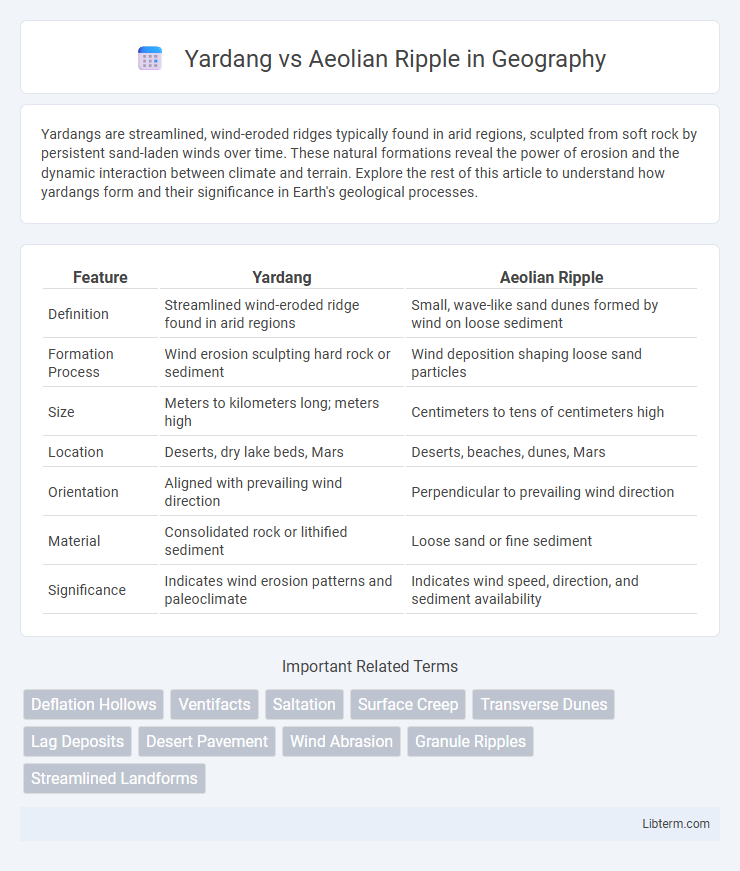Yardangs are streamlined, wind-eroded ridges typically found in arid regions, sculpted from soft rock by persistent sand-laden winds over time. These natural formations reveal the power of erosion and the dynamic interaction between climate and terrain. Explore the rest of this article to understand how yardangs form and their significance in Earth's geological processes.
Table of Comparison
| Feature | Yardang | Aeolian Ripple |
|---|---|---|
| Definition | Streamlined wind-eroded ridge found in arid regions | Small, wave-like sand dunes formed by wind on loose sediment |
| Formation Process | Wind erosion sculpting hard rock or sediment | Wind deposition shaping loose sand particles |
| Size | Meters to kilometers long; meters high | Centimeters to tens of centimeters high |
| Location | Deserts, dry lake beds, Mars | Deserts, beaches, dunes, Mars |
| Orientation | Aligned with prevailing wind direction | Perpendicular to prevailing wind direction |
| Material | Consolidated rock or lithified sediment | Loose sand or fine sediment |
| Significance | Indicates wind erosion patterns and paleoclimate | Indicates wind speed, direction, and sediment availability |
Introduction to Yardangs and Aeolian Ripples
Yardangs are streamlined, wind-eroded ridges formed primarily in arid environments where persistent directional winds sculpt soft sedimentary rocks, often reaching lengths of hundreds of meters. Aeolian ripples are small, regularly spaced sedimentary structures created by the saltation and surface creep of sand grains under wind action, typically measuring centimeters to decimeters in wavelength. Both landforms result from aeolian processes but differ significantly in scale, formation mechanisms, and sediment characteristics.
Geological Formation Processes
Yardangs form through intense wind erosion, where abrasive particles sculpt elongated ridges from consolidated sedimentary rock, typically in arid desert environments. Aeolian ripples develop on loose sand surfaces by the saltation and surface creep of sand grains driven by steady wind flows, resulting in smaller, regularly spaced wave-like patterns. The primary distinction lies in Yardangs representing large-scale erosional landforms shaped over geological time, whereas Aeolian ripples are dynamic, small-scale depositional structures formed rapidly by sediment transport.
Distinctive Morphological Features
Yardangs exhibit elongated, streamlined ridges oriented parallel to prevailing wind direction, typically formed in arid environments through wind erosion on cohesive rock or sedimentary layers. Aeolian ripples are small, regularly spaced, wave-like features on sand surfaces created by the saltation of sand grains under lower wind velocities. Unlike yardangs, which are large-scale erosional landforms with fixed orientation, aeolian ripples are dynamic, fine-scale depositional features characterized by consistent wavelength and amplitude.
Environmental Conditions for Development
Yardangs develop in hyper-arid desert environments where persistent strong unidirectional winds erode soft sedimentary rocks, emphasizing the role of wind abrasion and deflation. Aeolian ripples form in areas with abundant fine sand and moderate wind velocities that allow particles to saltate and accumulate, typically across desert surfaces with intermittent moisture. The contrasting environmental conditions highlight yardangs' formation in extreme aridity and rock durability, while ripples require loose granular material and dynamic wind-sand interactions.
Scale and Size Comparison
Yardangs, formed by persistent wind erosion, are large-scale landforms typically ranging from a few meters to several kilometers in length and can reach heights of tens of meters, making them prominent features in desert landscapes. Aeolian ripples, created by wind-driven sand transport, are much smaller surface patterns usually measuring a few centimeters to decimeters in wavelength and only a few centimeters in height. The stark contrast in scale highlights yardangs as major geomorphological structures while ripples represent fine-scale sedimentary features shaped by localized wind dynamics.
Material Composition Differences
Yardangs are typically composed of consolidated rock formations such as sandstone, siltstone, or claystone, which resist erosion and form elongated ridges sculpted by wind abrasion. Aeolian ripples, in contrast, develop on loose, unconsolidated sediment surfaces like sand or fine granular material, resulting from the saltation and surface creep of sand grains driven by wind. The key material difference lies in yardangs involving lithified substrates while aeolian ripples dynamically form on loose granular deposits.
Global Locations and Distribution
Yardangs are aerodynamic landforms predominantly found in arid regions such as the Sahara Desert in Africa, the Gobi Desert in Asia, and parts of the southwestern United States, formed through wind erosion of soft sediments. Aeolian ripples occur globally on sandy surfaces in deserts like the Namib in Africa, coastal dunes, and even Mars, created by wind-driven sediment transport on a much smaller scale than yardangs. Yardangs are typically aligned with prevailing wind directions over vast expanses, while aeolian ripples are more widespread and transient, marking active sediment movement in various environments worldwide.
Role of Wind in Shaping Landforms
Wind plays a crucial role in shaping both yardangs and aeolian ripples by sculpting the landscape through erosion and sediment transport. Yardangs form when strong, unidirectional winds erode softer rock layers, creating elongated ridges aligned with prevailing wind directions. Aeolian ripples develop as wind-driven sand grains saltate and accumulate in small, regular patterns on sediment surfaces, reflecting variations in wind speed and sediment supply.
Significance in Planetary Geology
Yardangs are streamlined wind-eroded ridges formed in cohesive sedimentary rocks, providing critical insights into past wind directions and atmospheric conditions on planetary surfaces such as Mars. Aeolian ripples, smaller-scale wind-formed sedimentary structures, reveal detailed information about surface sediment transport and wind regimes on Earth and extraterrestrial bodies. Both features serve as key indicators for reconstructing paleoenvironments and understanding aeolian processes essential for interpreting planetary surface evolution.
Summary of Key Differences
Yardangs are streamlined, wind-eroded rock formations typically found in arid desert regions, characterized by their large size and sculpted shapes aligned with prevailing winds. Aeolian ripples are small, regularly spaced sand patterns formed by wind-driven saltation on loose sediment surfaces, indicating local wind direction and strength. While yardangs represent durable geological features shaped over long periods, aeolian ripples are transient surface textures that can change rapidly with shifting wind conditions.
Yardang Infographic

 libterm.com
libterm.com